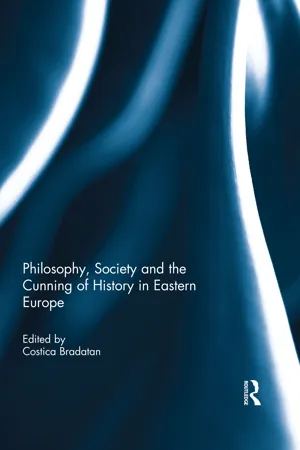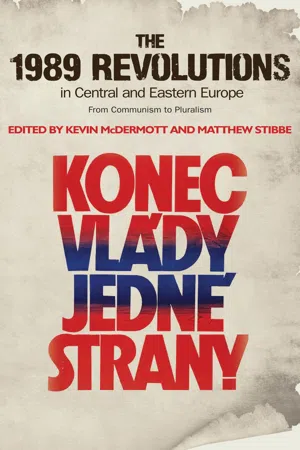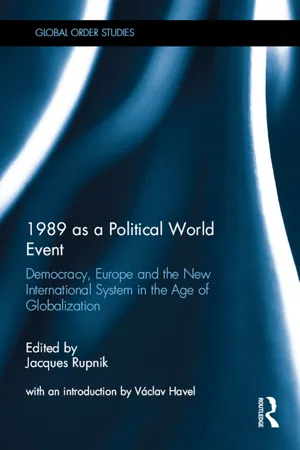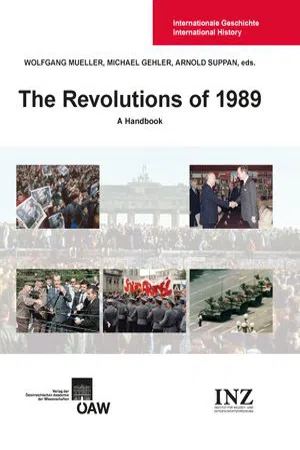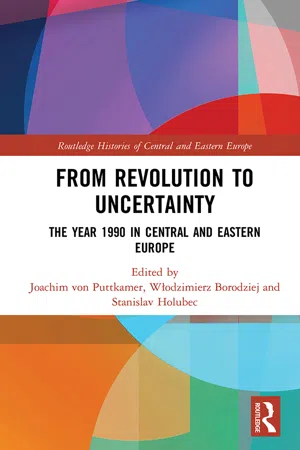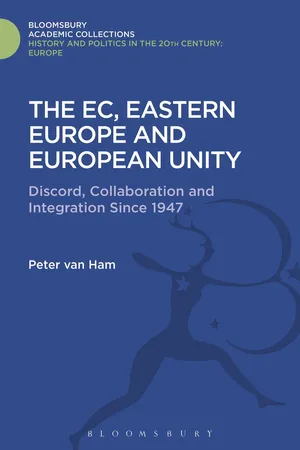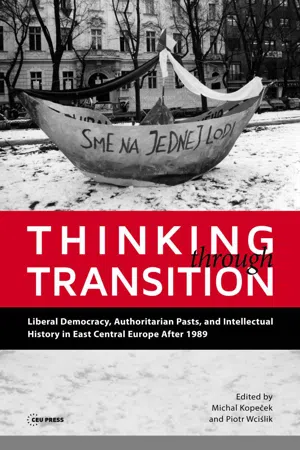History
Revolutions of 1989
The Revolutions of 1989 refer to a series of anti-communist uprisings that took place in Eastern Europe, leading to the fall of the Iron Curtain and the end of the Cold War. These revolutions resulted in the collapse of communist regimes in countries such as Poland, Hungary, East Germany, Czechoslovakia, and Romania, and paved the way for democratic reforms and the reunification of Germany.
Written by Perlego with AI-assistance
Related key terms
1 of 5
12 Key excerpts on "Revolutions of 1989"
- Costica Bradatan(Author)
- 2013(Publication Date)
- Routledge(Publisher)
michael bernhard THE Revolutions of 1989twenty years laterA nniversaries are artificial constructs, but they nevertheless provide us with an opportunity to reflect on the momentous events of the past. Those of a hagiographical bent are apt to grasp onto one great leader to explain the end of the Cold War as the product of that person’s visionary leadership. In this discussion I will endeavor to limit my invocations of Mikhail Gorbachev, Ronald Reagan, or Pope John Paul II as the motors of history. My task in this paper is to consider the meaning of the Revolutions of 1989 in Central Europe with the benefit of twenty years’ hindsight. I want to focus on their causes and their consequences. This reflection will be structured into several sections. I will begin with a theory of the causes of those momentous events that put an end to communist regimes in Europe. My perspective is that of a political scientist who takes development in a comparative and international context as a crucial motive force in history. But I do not want to omit those who actually engaged in struggle in the countries where the revolutions took place. This discussion of the causes of the revolution will conclude with a brief overview of the events of 1989. I will then address its consequences from three perspectives. First, it has importance in terms of how we understand the past. Second, as an event it had profound historical meaning on its own terms. And third, it has shaped our contemporary world, in particular the current international system.the causes of 1989The most important cause of the Revolutions of 1989 was the exhaustion of the Soviet model of economic development. Had their economic model succeeded, it is highly unlikely that we would have witnessed the demise of the system. And, on the face of it, this is confirmed by the continued viability of one-party states in places like China and Vietnam, which have managed to overcome the limits to growth that undid Soviet-type regimes in Europe.- eBook - ePub
Revolutions and the Revolutionary Tradition
In the West 1560-1991
- David Parker(Author)
- 2002(Publication Date)
- Routledge(Publisher)
12 The anti-Communist revolutions in the Soviet Union and Eastern Europe, 1989 to 1991Robert V. DanielsThe collapse of Communism and the nature of revolution
Two unforgettable images bracket perceptions of the revolutionary fall of Communism: the opening of the Berlin Wall in November 1989, and Boris Yeltsin standing on a tank in Moscow to defy the hardline coup plotters of August 1991. Between and around these landmark events swirled a storm of defiance and rebellion that brought about one of the most spectacular developments of the twentieth century, when the old political order in the Soviet Union and its bloc of East European satellite countries came to an end. By many standards – the break in governmental continuity, the depth of change, the reversal in dominant public attitudes – this movement was one of the great revolutions of history, as its protagonists, including Soviet General Secretary Mikhail Gorbachev, believed. Yet there are peculiarities about this upheaval – the lack of violence in most places, the centrality of national independence, and the targeting of the Soviet system that was itself the product of revolution in 1917 – that raise the question whether it was a true revolution.It is important to understand what the Soviet and East European anti-Communist revolutions were actually contending against. ‘Communism’ is often construed as the revolutionary doctrine of Karl Marx, implemented in Russia by Vladimir Lenin to begin a seventy-year ‘utopian experiment’ that ultimately ‘failed’. In reality, the old regime preceding the Revolutions of 1989 to 1991 was no longer an experiment, but a post-revolutionary, imperialist dictatorship dressed up in the language of Marxist ideology. - eBook - ePub
The 1989 Revolutions in Central and Eastern Europe
From Communism to Pluralism
- Kevin McDermott, Matthew Stibbe, Kevin McDermott, Matthew Stibbe(Authors)
- 2015(Publication Date)
- Manchester University Press(Publisher)
Moreover, when considering who were the key actors in 1989, we would argue that this was a revolution made not just by the people demanding freedom to live outside politics, and not just by those who rejected, or were deeply sceptical, towards Marxism and other ‘grand narratives’, but also by pragmatic centrist reformists from the old regime. Gorbachev was one of them but there were others – the Hungarian communists who took the decision to dismantle the old Cold War frontier with Austria, the Polish regime of Wojciech Jaruzelski which led the PZPR into an historic power-sharing agreement with the opposition Solidarity movement in August 1989, even Modrow in the GDR, who developed a reputation as a reformer from his base as SED first secretary in Dresden. It was they who saw most clearly that the old system could not survive in its current form and that the time for change had come. The events of 1989 were the unintended outcome of their commitment to a more open, pluralistic non-bureaucratic form of Marxism, shorn of every last vestige of Stalinism and more receptive to reforms being instigated in the USSR, as much as it was a reflection of popular and dissident demands for an end to four decades of communist tyranny and Soviet overlordship.Notes1 P. Roth, American Pastoral (London, 1997), p. 87. Also cited in S. Moyn, The Last Utopia: Human Rights in History (Cambridge, MA, 2010), p. 4.2 Cited in S. B. Snyder, Human Rights Activism and the End of the Cold War: A Transnational History of the Helsinki Network (Cambridge, 2011), p. 238.3 E. Hobsbawm, Age of Extremes: The Short Twentieth Century, 1914–1991 (London, 1994), pp. 2–3; F. Bozo, Mitterrand, the End of the Cold War, and German Unification, trans. S. Emanuel (New York and Oxford, 2009) [2005], pp. 389–90.4 On the universal significance of 1989, see G. Lawson, C. Armbruster and M. Cox (eds), The Global 1989: Continuity and Change in World Politics (Cambridge, 2010). The most recent broader overview is V. Tismaneanu and B. Iacob (eds), The End and the Beginning: The Revolutions of 1989 and the Resurgence of History (Budapest, 2012).5 While in what follows we focus mainly on works by historians, political scientists, sociologists and anthropologists have also contributed extensively to the field. See, for example, R. Dahrendorf, Reflections on the Revolution in Europe (London, 1990); S. P. Huntington, The Third Wave: Democratization in the Late Twentieth Century (Norman, 1991); K. Verdery, What Was Socialism, and What Comes Next? (Princeton, 1996); V. Bunce, Subversive Institutions: The Design and the Destruction of Socialism and the State (Cambridge, 1999); V. Tismaneanu (ed.), The Revolutions of 1989 (London, 1999); K. Kumar, 1989: Revolutionary Ideas and Ideals (Minneapolis, 2001); J. Foran, D. Lane and A. Zivkovic (eds), Revolution in the Making of the Modern World: Social Identities, Globalization and Modernity - eBook - ePub
1989 as a Political World Event
Democracy, Europe and the New International System in the Age of Globalization
- Jacques Rupnik(Author)
- 2013(Publication Date)
- Taylor & Francis(Publisher)
Part I The meanings and legacies of 1989Passage contains an image 2 The world after 1989 and the exhaustion of three cycles
Jacques RupnikThe year 1989 was dubbed annus mirabilis because of the suddenness and the surprising ease of the collapse of dictatorships and the international order inherited from the Cold War. Václav Havel, who started the year in prison and ended it in the Prague Castle as president, symbolized the moment. The unpredictability of history provides the theme of his beautiful opening essay in this volume, which hints ironically at journalists and political scientists who thought they understood the “system” and the “laws of history”. This indeed remains one of the important lessons for students of international affairs: experts and social scientists failed to anticipate the possibility of a “1989” although they had no shortage of knowing arguments after to demonstrate why collapse had been inevitable …This is not a book about the events of 1989, but about 1989 as a “world event”. The fall of the Berlin Wall symbolically marked the end of the Cold War, heralding the transformation of the international system that had prevailed since the end of World War II. It clearly represents a caesura, the closure of the “short twentieth century” (1914–1989) marked by two world wars and two totalitarianisms that originated in Europe. As a peaceful transition to democracy and the “return to Europe”, 1989 had a global resonance, but the dispersion of its echoes also revealed a plurality of meanings. Though originating in Europe – the initial core of the cold-war system – it may have been the last time Europe constituted the center-stage of a world event. The center of gravity has since been shifting eastward, from the Atlantic to the Pacific. Two decades after the “return to Europe”, some are heralding its eclipse.1989 had a global impact, but meant different things to a variety of actors in different parts of the world. A Western or “Eurocentric” narrative of 1989 thus needs to be confronted with contrasting perceptions from Asia or Africa. In Asia, it marked the advent of global capitalism, but not quite the end of the Cold War, as Communist China, Vietnam and a divided Korea remind us. 1989 was democracy’s founding moment in the heart of Europe, but, while on June 4 Poland held its first free elections, on the very same day the pro-democracy movement was crushed in Tien an Men square in Beijing. What was seen at the time as setting China at odds with the democratic tide of 1989, is in retrospect perceived in Asia as the opening of China’s spectacular rise on the international scene as an economic and strategic superpower. - Wolfgang Mueller, Michael Gehler, Arnold Suppan(Authors)
- 2014(Publication Date)
This division of Yugoslavia 65 refects a larger division between two groups of countries: 65 Cf. Norman M. Naimark and Holly Case, eds., Yugoslavia and Its Historians: Understanding the Balkan Wars of the 1990s (Stanford: Stanford University Press, 2003). The Revolutions of 1989: An Introduction 18 In Poland, Hungary, Czechoslovakia, and the GDR multiparty elections brought the victory of non-communist forces; in Bulgaria and Romania members of the (reform) communist elite took power in palace revolts and were then confrmed in elections. 66 Transnational links and external factors Most authors agree that the Revolutions of 1989 were not disconnected nation-al phenomena, but were reinforced by inter- and transnational links and spillover effects. As can be seen by the American, French and Polish revolutions of 1776, 1789 and 1791/94 with their transatlantic repercussions, the upheavals from Lat -in America to the Mediterranean region and St. Petersburg from 1820 to 1825, the Russian and Central European revolutions in the aftermath of World War I as well as the de-Stalinization crises of 1953–56, this is certainly not a new phe-nomenon. The revolutions of 1830 and 1848 in particular were transnational events with far-reaching spillover effects ranging from Paris to Warsaw and from Palermo to Budapest. 67 Before and during 1989, ideas of reform and democratic participation spread from Western Europe to the East, from Eastern Europe to Russia and vice versa, and from Eastern Europe to China. Among the dissident groups of the late 1980s, a widespread network of transnational links and interactions existed at the grass-roots level. Later this reached up to the top: Collaboration between Polish activists and their Czechoslovak and Hungarian as well as Baltic and Ukrainian colleagues included students’ contacts, the smuggling of hardware and know-how, 68 and pro-tests against the Tiananmen massacre in front of the Chinese embassy buildings in Warsaw and Budapest.- eBook - ePub
Revolution And Transition In East-central Europe
Second Edition
- David Mason(Author)
- 2018(Publication Date)
- Routledge(Publisher)
The Eastern European Revolutions of 1989 fit many of these past revolutionary patterns. The natural history of these revolutions accord closely with those described by Brinton and others. The major difference was the accelerated time frame of the Eastern European events. Except in Poland, where the origins of the revolutionary movement date to 1980, the Revolutions of 1989 proceeded much more quickly than did past revolutions. As noted earlier, this was due both to the symbiotic nature of change in Eastern Europe, with each country building on the achievements of the other, and to the accelerating impact of the mass media, which allowed people all over the region to know almost immediately what was occurring elsewhere.In Eastern Europe, perhaps even more so than in previous revolutions, the revolutionary movements were able to win over key personnel within the political elite. In every country, there were reformist elements within the communist parties who supported substantial change, if not the total abandonment of one-party rule. As early as 1988 in Hungary, for example, the reformist wing of the communist party allied itself with the emerging forces for change. In 1989, as the revolutions progressed in East Germany, Czechoslovakia, and elsewhere, hard-line party figures were replaced by increasingly more accommodating party leaders, who eventually were willing to negotiate with the opposition and concede free elections. As we have seen, this was partly a result of the loss of confidence and morale within the communist parties and the increasing inability of the old party elites to handle the challenge of change. In Skocpol’s terms, this was a breakdown of the governing apparatus, due in large measure to changes in the international situation, that is, a more progressive and tolerant leadership in Moscow.The benevolent neutrality of the party elites in Eastern Europe and the Soviet Union was a key factor in the Eastern European revolutions, and it deserves further discussion. Not only was this an important reason for the success of these revolutions, it was also a major reason for their nonviolence. - eBook - ePub
Human Rights and Political Dissent in Central Europe
Between the Helsinki Accords and the Fall of the Berlin Wall
- Jakub Tyszkiewicz(Author)
- 2021(Publication Date)
- Routledge(Publisher)
12 Revisiting the revolution of 1989The end of the communist rule in Romania
Dragoş PetrescuDOI: 10.4324/9781003187646-13The regime change in Romania was the last in a line of six regime changes that took place in 1989 in East-Central Europe (ECE). The regime change in Romania was unexpected, brief, and violent, in contradistinction to the five regime changes which preceded it, as it unfolded during the second half of the month of December 1989 and resulted in over 1,100 dead and 3,300 wounded. The violent nature of the 1989 events in Romania should be stressed once again, in opposition to the nonviolent regime changes in Poland, Hungary, East Germany, Czechoslovakia, and Bulgaria. This particular aspect of what is generally known as the Romanian revolution of 1989 has been stressed by many scholars. As sociologist Daniel Chirot observes, nonviolence was the norm in the 1989 events in ECE: “1989 was amazingly conflict-free because the ruling elites did practically nothing to save communism.”1 As for Romania, historian Timothy Garton Ash wrote at the time that the 1989 events in that country did look like a revolution: “Nobody hesitated to call what happened in Romania a revolution. After all, it really looked like one: angry crowds on the streets, tanks, government buildings in flames, the dictator put up against a wall and shot.”2 One can go further and argue, together with J.F. Brown, that the December 1989 events in Romania added to that same year’s regime changes in ECE, the missing elements of “classic” revolutions, which includes violence, bloodshed, and tyrannicide.3This chapter is concerned with the causes of the Romanian communist regime’s violent collapse and argues that external factors were determinant in bringing down communist rule in that country. Furthermore, this chapter argues that dissident discourses and actions centered on the issue of human rights only had a limited impact on the final demise of the Romanian communist regime. Other issues related to the 1989 Romanian regime change such as its ambiguous and contested outcome, short-term consequences, or enduring legacy from a 30-year perspective are not addressed here due to the limits of this chapter. - eBook - ePub
- Gareth Dale(Author)
- 2006(Publication Date)
- Routledge(Publisher)
Part III The revolution of 1989Passage contains an image
7 The summer crisis
At the beginning of 1989 the Soviet bloc was entering a major crisis, the course of which was not predictable any more than its eventual outcome was inevitable. A series of remarkable policy shifts in Hungary and Poland were underway. In January, non-Communist parties were legalised in Hungary. In February, Round Table talks began in Poland. In April, the Hungarian leadership resigned. In May, Budapest began to dismantle the fortifications on its border with Austria. In June, the Polish Communist Party relinquished its hold on power. All of these transformations met with the Kremlin’s approval, or at least toleration (although it did insist that in Poland Communists retain the defence and interior ministry portfolios). Soviet leaders and advisers knew that their room for manoeuvre was narrow. Intervention by Soviet forces, they feared, could light the touchpaper under Eastern Europe as a whole. Even if the ruling parties in Eastern Europe held to a conservative course, ‘a political eruption’ – or even an ‘acute social-political conflict with an unfathomable outcome’ – could ensue.1 Further reforms, it seemed, were inevitable; the hopes (and assumptions) in Moscow were simply that these would be controlled by reform Communists or other pro-Soviet forces. The Kremlin’s approach was cemented in July with Gorbachev’s formal repudiation of the Brezhnev doctrine.In East Berlin a stiff silence was maintained throughout these months, punctuated by formal declamations of the unity of the socialist bloc. Behind the scenes, however, severe annoyance was expressed at what an incensed Honecker described as Hungary’s ‘slide into the bourgeois camp’.2 The reforms in that country and in Poland, he warned, represented ‘the visibly accelerating erosion of socialist power, achievements, and values’.3 In meetings with their Soviet-bloc counterparts, he and Stasi chief Mielke expressed ‘profound concern’ at these developments. At one point Mielke even hinted that co-operation with the KGB would be in jeopardy if Soviet foreign policy continued on its ‘tactless’ course.4 - eBook - ePub
- Rosemary Wakeman(Author)
- 2003(Publication Date)
- Routledge(Publisher)
8 The Central and Eastern European Revolution, 1989–2000Ivan T.Berend“Yugoslav Communism, separating itself from Moscow,” stated the legendary Yugoslav dissident, Milovan Djilas, “initiated the crisis of Soviet imperialism.” However, he added, “The wound which the Hungarian Revolution inflicted on Communism can never be completely healed… Hungary means the beginning of the end of Communism…”1 “The October Revolution in Poland,” declared an enthusiastic contemporary reporter, “was more lasting…[and] more deadly to Communism. Where the Hungarian revolt failed, the Polish half-succeeded.”2 The Polish Communist Party, maintained Norman Davies, “never gained the strength or the confidence to advance beyond the compromises.”3 These three perspectives provide some impression of the complexity involved in assessing the struggle that engulfed Eastern Europe in the years after the Second World War. This chapter will discuss the evolution of communism in Eastern Europe, the revolts that provoked its collapse, and the efforts to “return to Europe” as a framework for modernization and reform after the upheavals of 1989.Roots: revolutions, liberalization, crisis, and erosion, 1956–88
The Stalinist regime and Soviet domination of Central and Eastern Europe introduced after the Second World War, in most cases, had no popular support and indeed generated a genuine, fundamental resistance. The first lethal blow was Tito’s split with Stalin in 1948. Tito alone openly rejected Soviet leadership and began organizing a socialist Balkan confederation—a potential rival to the Soviet Union. Stalin reacted furiously and attempted to remove Tito, but failed. The result was that Yugoslavia followed its own independent road. The “October Revolutions” in Poland and Hungary, in 1956 represented two further setbacks. A spontaneous worker’s uprising in Poznaæ and then its military suppression generated a deep political and moral dilemma among the Polish communist elite. They reacted by removing the Stalinist leadership and re-elected Wł adisł aw Gomuł ka, the purged and imprisoned “nationalist deviator,” as Secretary General of the party. It was an open and successful revolt against Soviet political intervention. The Hungarian revolution at the same moment turned into the only national, armed uprising and, albeit briefly, the only successful military struggle for independence against the Soviet Union. Under the momentary leadership of Imre Nagy, it led to the collapse of communism, a declaration of neutrality, and the reintroduction of a multiparty democracy. - eBook - ePub
From Revolution to Uncertainty
The Year 1990 in Central and Eastern Europe
- Joachim von Puttkamer, Stanislav Holubec, Włodzimierz Borodziej(Authors)
- 2019(Publication Date)
- Routledge(Publisher)
6 Talkin’ ’bout a revolution On the social memory of 1989 in Hungary Éva KovácsWas 1989 a memorable year in Hungary? Currently, the year of the regime change does not play a formative role in memory politics. However, it was once annus mirabilis for many Hungarians. On the contrary, it is now retrospectively referred to as annus miserabilis : the defeat of young Hungarian democracy by global capitalism. This essay describes the divergence between the memory of the fall of communism as an exhilarating event and its depressing aftermath as an irreversible development in the Hungarian memory landscape.1By analyzing the political involvement of Hungarian society at the very moment of regime change, dozens of national and local events can testify to the formative character of the political transition from the perspective of the people at large. Retrospectively, however, the transition did not fulfil their expectations. The 1989 revolution brought about a euphoric rite de passage between the past and the present. It was not immediately apparent that anti-communism would parallel not only the refusal of previous political values, but also the quick devaluation of former lifestyles, social milieus, and mentalities; that is to say, many people had to negate their former life. Therefore, for those who were unable to follow the road of radical stigmatization of the ancien régime , the disqualification of everyday life under socialism resulted in the ‘passive forgetting’2 of the whole era in collective memory. Ten years later, with emerging poverty, the deterioration of political and economic prospects and the actual living conditions, passive forgetting turned into a retrospective idealization of the communist regime and a generalized criticism of capitalism.Currently, 1989 is not considered a historic year in Hungary. It does not play a formative role either in public history or in memory politics. Although some of its significant days – e.g. 15 March, 16 June, 23 October, and 26 November 1989 – once marked important events in the transition from communism, today they do not inspire either social memory or current social action. Because 1989 symbolized the miraculous end of communist regimes, the term annus mirabilis was once widely used to describe the political events that took place in Eastern Europe. Today, however, it is often referred to – by the very same intellectuals who once championed it – as annus miserabilis: - eBook - PDF
The EC, Eastern Europe and European Unity
Discord, Collaboration and Integration Since 1947
- Peter van Ham(Author)
- 2016(Publication Date)
- Bloomsbury Academic(Publisher)
The economic and political reforms in the USSR provided more leeway for the regimes in Eastern Europe to experiment and to explore the limits of Soviet hegemony. The Brezhnev doctrine had been revoked and it all seemed as if the lid was now removed from the Communist box of Pandora, with, undoubtedly, many surprises lying in store for Europe at large. In this chapter we will examine the East European Revolutions of 1989-90 in relation to the 1992 initiative of the EC. We will argue that both the reform 1989 AND 1992, TWO REVOLUTIONS? 145 plans in Eastern Europe and the reformist zeal in Western Europe have been initiated in response to corresponding endogenous pressures generated by the structural changes taking place in world politics at large. 8.2 Two parallel revolutions? The process of change in the East started with President Mikhail Gorbachev entering the political stage in Moscow in March 1985. Approximately at the same time, the momentum of West European integration was increased from the lethargic Europessimism of the late-1970s and early-1980s into the Europhoria of the 1992 initiative. It is beyond doubt that one should always be particularly cautious to assume a causal relationship between social events which are happening simultaneously. This is also the case when we want to place the perestroika and the 1992 initiatives into proper perspective. At the same time, it remains tempting to suppose something beyond sheer coincidence in the fact that the publication of the so-called 'White Paper' (June 1985) practically coincided with the genesis of Soviet perestroika. We will argue that the causes of both initiatives can be brought back to similar motivations and that both perestroika and the 1992 programme have served comparable purposes. - eBook - PDF
Thinking through Transition
Liberal Democracy, Authoritarian Pasts, and Intellectual History in East Central Europe After 1989
- Michal Kopeček, Piotr Wcislik, Michal Kope?ek, Piotr Wcislik, Michal Kope?ek, Michal Kopeček, Piotr Wciślik, Michal Kopeček, Piotr Wciślik(Authors)
- 2015(Publication Date)
- Central European University Press(Publisher)
3 4 (2010): 125 138. 490 Mark, Blaive, Hudek, Saunders, and Tyszka curred twice over. Not only did some of the population fail to accept the wholly negative view of communism that post-1989 democracy sought to impose through its commemoration policy, it also seemed to share little of the positive vision of “1989” that the intellectual elites tried to convey. 79 Local studies revealed that many rejected the idea that one was disavowing democracy by finding advantages in the communist period, or that it was necessary to be anti-communist to appreciate democracy. In this sense, oral history demonstrates a lack of identification with this “1989 ideology.” For this reason, 1989 was often absent in one oral history study conducted in Č eské Velenice near the Czech-Austrian border: one lady who was inter-viewed could not remember what had happened in 1989 and when asked if the term “Velvet Revolution” meant anything to her, answered, “Ah yes! But that was in Prague!” 80 Interviewees in the Slovak town of Komárno, especially ethnic Hungarians, had to be repeatedly reminded about 1989: they knew of the Velvet Revolution’s existence but could not always re-member in which year it took place and evidently failed to ascribe a signifi-cant meaning to it in their everyday lives. 81 Surveys in Slovakia indeed suggested that the low attendance at commemorations of the Velvet Revolu-tion was the result of not only disillusionment at the technocratic, cynical, and corrupt style of post-socialist governance, but also due to the fact that the post-1989 generation appeared to know very little about the Velvet Revolution and its leaders. 82 For them, a commemoration on November 17 th meant little or nothing at all.
Index pages curate the most relevant extracts from our library of academic textbooks. They’ve been created using an in-house natural language model (NLM), each adding context and meaning to key research topics.
